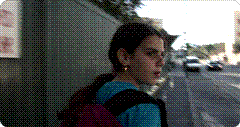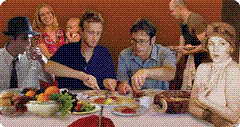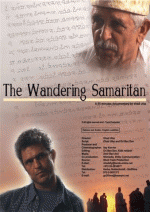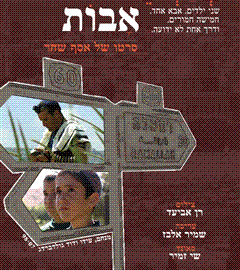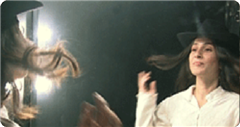This touching film interweaves seven parallel stories of children on their way to and from school into one journey. We witness the most intimate moments – between parent and teacher; danger and curiosity – where a child’s sense of independence is developed. It is a meditation on child consciousness, a rite of passage that goes in a blink of an eye to dissolve into adulthood. Side Walk is about the playful, the stressful, the violent, the magical and the mostly thrilling daily journey of childhood.
In May 2000, the South Lebanese Army (SLA) collapsed and its members fled in fear of Hezbollah fighters into Israel, their ally who had abandoned them. 700 families of SLA refugees remain in Israel today. Pierre and Massoud are sons of an SLA officer who brought his family to Israel when the two were boys. Pierre aspires to dedicate himself to the Lebanese music he loves, but he is forced to support his family instead. Massoud brings together a group of friends, all sons of former SLA fighters, and starts a basketball team called Erez Naharia (“Cedars of Naharia”). This is the story of children who were born in war-torn southern Lebanon and fled with their parents to Israel a story of youth and dreams in the shadow of war, betrayal and exile.
The Ashkenazim is a humorous and moving film about young Israelis in search of their Ashkenazi roots. These women and men seek to reconnect with their Jewish European heritage which they feel was suppressed in order for their ancestors to acclimate to their new Israeli and Middle Eastern environment. The Ashkenazim follows the lives of a group of young women and men as they reconnect to their Ashkenazi roots. Assaf Galay forms “Ashkenazi Identity” to promote a cultural revolution in Israel. Tammy Ben-Tor creates an electro- Yiddish sexy cabaret. Itamar Handelman Ben Canaan, always ashamed of his Ashkenazi roots, falls in love with Olga, a new immigrant from Russia, and with her returns to the life style of his European ancestors. What makes these Israelis look back with longing at their Ashkenazi history and can they bring some of their forefather`s lost Jewish European culture to the Middle East?
Gadi Tzdaka has always felt trapped by the “ghetto walls” of the Samaritan neighborhood, with its strict form of education and stringent religious laws. His father Hillel wanted his first born son to adopt devout religious faith as he had, but Gadi longed for freedom. Gadi’s ancestors, the ancient Samaritans, split off from Judaism 3,000 years ago. They celebrate their holidays with pilgrimages to the ancient altar on Mt. Gerizim. Today, only 600 Samaritans remain. They live in two neighborhoods: one in the Palestinian city of Nablus and the other in the Israeli city of Holon. All those who left the neighborhood up to the present also ended up leaving the sect. At age 33, Gadi wants to live his own life – to be free to love, work, create, and raise his children in a more modern way. Filled with misgivings and indecision, he leaves the Samaritan neighborhood, despite the protest of members of his sect and his father`s anger. The Wandering Samaritan is about a man confronting his own past and identity. It documents the life of Gadi and the Tzdaka family on a personal level and explores the Samaritan tradition and the Samaritan way of life. The film portrays Gadi as a person straddling the fence between Israel and Palestine and between east and west. He is torn between his desire to preserve tradition and his hopes for progress and freedom — between his respect for his father and his desire to fulfill his own dreams.
This film takes us on the unusual journey of a father and his two sons, who decide to make a pilgrimage from the north of Israel to Jerusalem’s Western Wall – all in the midst of the Second Intafada. Menachem Goldberg, a charismatic dreamer, and his two sons, ages eight and ten years old, begin their trip just prior to the start of the Passover Holiday. Menachem’s desire to journey in the paths of their fathers becomes an expression of the current realities of the Middle East. Along the way, through Arab and Jewish settlements, Menachem is struck by the juxtaposition of modern life with ancient beliefs. As Menachem attempts to come to terms with the dissonance that exists in the occupied territories, he also comes to terms with his own inner dissonance. At the heart of this film is the intimate view given of this family. Menachem’s optimistic spirit, bonding with his sons, and his attempts to make peace wherever he goes, penetrates straight to our hearts. Ultimately, we are left with a great sense of hope.
The short film examines the decay of the company town Dimona populated mainly by Morocccan Jews, and mostly known as the home of Israel’s atomic program. The film explores the fate of those residents who are left without jobs and without a viable future when the main employer, a textile factory, closes.
To some, Yiddish is a dead culture, but an increasing number of people feel strongly that the richness of its heritage is something to be preserved and passed down to future generations. The film presents these dilemmas on the rehearsal stage of the Yiddish Spiel Theater, where the performances themselves, filmed in Europe and Israel, allow audiences to identify with the stories and the emotions of this once vibrant culture. The film deals with Yiddish culture in its various aspects, from the Jewish kitchen to the most profound literature. The longing for this vanishing culture is expressed by a young Israeli student and an old woman from the Ukraine who remembers a Yiddish song that she heard as a child from her mother. Another way to preserve the language is shown by a youth band, who sings Yiddish to rock rhythms. The film swings between sadness and joy, tears and laughter, just like Yiddish songs.
Israel Kletzkin owns a printing press and has written and printed hundreds and thousands of pashkavils. Yoel Krause has been collecting them for 20 years and has over 20,000 in his possession. Yoel is the most authentic representative of the Neturei Karta, the radical anti-Zionist stream in ultra- orthodoxy. He has no Israeli ID card, no social security and no contact with the State. He is 34 years old and lives in a one-room apartment. He has 9 children, and he and his wife Rachel plan on having 22. Yoel doesn’t eat “Zionist” food. Rachel bakes bread and he has his own cow in order not to purchase milk from the Israeli dairies. For him, the Zionists are the source of all evil. Our camera managed to penetrate, for the first time, the private and intimate moments and to really get to know them. Israelis different, so different that he even put in a bid and became the official pashkavil paster of the city of Jerusalem. Israel is charismatic, talented, a joker and savvy businessman who insists upon leading his life as he wills, having his picture taken. He has become an obvious target for the radicals who conduct a war with him on-camera. Both men are believers who will not compromise their respective ways of life.
My Neighbourhood follows Palestinian teenager Mohammed El Kurd as half of his home in East Jerusalem is taken over by Jewish settlers. When Israeli activists arrive to protest the takeover alongside Palestinian residents, Mohammed comes of age in the face of unrelenting tension and unexpected cooperation in his backyard.
Video cassettes filmed years ago in New York reappear one day in a couple’s home. The content undermines the man’s trust in his wife. Who is the man who filmed this video twenty years ago? Why did she agree to cooperate with him in front of the camera? The dispute around the video footage leads the woman to seek out those who were her companions in a tumultuous experience; with their help she uncovers the ways in which her repression mechanism led her astray.
